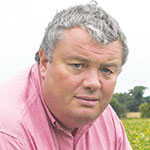Crop Watch: Cold snap sought to control disease
 © Tim Scrivener
© Tim Scrivener It’s the final Crop Watch of the season as the list of agronomy jobs dwindles away and growers head for the workshop, but Iain Richards is warning southern growers to continue to keep a close eye on disease levels.
Even the most hardy late-drillers have largely concluded operations in the West, says Stephen Harrison, who advises anyone considering planting in plasticine-like conditions to think again and preserve soil structure.
Wetter conditions in the North have seen an army of slugs slither into later-sown crops that are struggling to get going, and Andy Goulding advises growers to take the opportunity to investigate fields that have failed.
See also: How to lift yields with phosphates and micronutrients
Holding fire on propyzamide applications could see an improvement in performance of up to 20%, says Sean Sparling, who advises there is plenty of time left to wait for more moisture and cooler temperatures.
West: Stephen Harrison

Stephen Harrison
AICC/Southwest Agronomy (Avon)
I believe it is fair to say that drilling is now virtually complete. All planned crops have been put in the ground save for a handful of late crimped maize.
Unless ground conditions improve drastically, these fields may well be spring cropped. It is far better for the long-term sustainability of the soil to cultivate it when it is not like plasticine.
In some cases, spring cropping after maize is a deliberate blackgrass strategy. The combination of a late-sown spring crop followed by a winter break is a powerful tool.
Wheat sown in the normal October window has established well. Mildew can be found in Graham, although a few frosty nights have slowed it down.
No autumn fungicides have been applied. No aphicides for barley yellow dwarf virus control have yet been applied. All wheat was Deter (clothiandin) dressed. The T-170 sum for dressed seed starts six weeks after drilling and has not yet been achieved.
The same applies to winter barley. If any seed was not dressed with clothiandin, ensure any pyrethroids are applied at full label rate to counter resistance.
Light leaf spot control options tighten
Since the advent of Clearfield technology, charlock control has occupied far less nervous energy. The issue of light leaf spot is rather more vexed despite lower levels this autumn.
The decision to treat has been aided by some reinfection of phoma. Given that the initial phoma fungicide had little light leaf spot activity, we will include a 75% dose of an appropriate material with the propyzamide.
The revocation of picoxystrobin and corresponding loss of co-formulations means this is likely to be a triazole in future.
Worryingly, from a resistance perspective, this could mean four triazoles being applied to an oilseed rape crop.
The end of the autumn season for crop activities heralds the beginning of the winter conference season, a chance to digest trials results and plan for next spring.
South: Iain Richards

Iain Richards
Agrii (Oxfordshire)
As winter begins to make its presence felt, we are in a far better place than we feared we might be two months ago. But we’re staying alert on several fronts.
With much more phoma about this autumn, we have sprayed most of our oilseed rape with prothioconazole-tebuconazole co-formulations in the past two weeks, adding extra tebuconazole to calm down the thickest canopies – now up to eight big leaves.
Even though soil temperatures have fallen back, we are holding off on our propyzamide applications to give the rape canopies a chance to open up with the colder weather.
We always get better control from the later treatments that give us the best soil cover. They also allow us to target any light leaf spot, if necessary, with a timely pre-Christmas dose of prothioconazole.
Surprising levels of late flea beetle activity necessitated an insecticide with our first fungicide sprays. But we have seen enough adults since then to worry about larval levels.
The vigorous hybrids we are mostly growing and excellent October crop development should help to combat these. It’s still a worry, though.
Concerns persist over disease levels
Also worrying is the level of disease we have been seeing in our earlier cereal drillings. The amount of mildew on winter barley is something we are keeping a very close eye on.
While not so immediately concerning, the brown rust that has been easy to find on Crusoe does mean we have earmarked a decently curative T0 here for the spring.
Barley yellow dwarf virus (BYDV) is another worry. Our earlier drillings have already had a follow-up spray to bolster their Deter (clothiandin) treatment – very necessary with the amount of growth they have put on in recent weeks.
The dressing means we shouldn’t need to overspray most wheats drilled from mid-October. However, we’ll have to keep a close watch on the T-sum build-up with the BYDV Alert app in case we get another winter like 2015-16.
Thankfully, our emphasis on delayed wheat drilling, seed-bed management and rotational changes have meant blackgrass isn’t quite such a major concern as it has been in many wheat crops in recent seasons.
Later drilling does mean we have to put more care and attention into early spring nutrition to maximise root and tiller development. But this is a small price to pay for the sort of weed control we just can’t get from the can anymore.
North: Andy Goulding

Andy Goulding
CAS/Hutchinsons (Cheshire)
The dry weather spoken of in Lincolnshire and East Anglia by fellow Crop Watchers would be a very welcomed sight over here in Cheshire.
The few early-drilled crops have established well and look in good shape, going into the winter with little concern.
Later-drilled crops are emerging in a slothful manner as the wet soils have cooled rapidly in the seeding zone.
In some areas, the seed has rotted away under the anaerobic conditions and more land than we would hope for is sodden and exposed. However, this does leave fields in an ideal condition to be inspected for spring cropping.
Problem areas identified and inspection pits are easy to dig and assess as the soils are in a weaker state.
That reads easy – but the act of doing it is less so. It can, however, lead to huge differences in cropping performance for a given field.
Widespread incidence of slug pressure
One common theme this autumn is the prevalence of slugs. They are following the normal risk patterns overall, but there are some fields wthat would be considered low risk that are being chomped away at.
Growers who haven’t used pellets for nearly a decade are finding themselves targeted as crops struggle to grow away in cooling conditions.
The slug pellets of choice here are ferric phosphate. I have seen some that have been down for more than two weeks and had nearly 60mm of rain on them still remaining in a baitable shape.
Couple that with the restrictions on metaldehyde and it is an easy decision to make.
Most of the fertiliser market is accounted for, but much is sold with the emphasis on price, with limited or no advice on best practice, profitability and practicality.
It is therefore worth noting that sulphate will leach in the same manner as nitrate. The two work together and sulphate will improve nitrate use, so a little-and-often approach is necessary for cereals with their prolonged vegetative growth period.
East: Sean Sparling
 AICC/SAS Agronomy (Lincolnshire)
AICC/SAS Agronomy (Lincolnshire)
Low rainfall and just one significant frost (nowhere near cold enough to kill aphids, by the way) mean soil temperatures remain high and crop growth continues at a pace.
Delaying the wheat drilling in blackgrass fields has paid dividends once again, with wheat growth and emergence way outpacing the blackgrass.
We asked a lot of the pre-emergence herbicides last month by applying them to dry, often imperfect seed-beds, but it proved how important it is to get them on within three to four days of drilling.
When conditions changed and applications had to be made at the very early post-emergence stage of the crop, blackgrass control is noticeably poorer.
Where blackgrass has found its way through and is on average at GS12, applications of Atlantis (iodosulfuron+mesosulfuron) are now being made – with everything crossed that it might still do some good.
As always with this herbicide, the key to success (as long as the blackgrass is still susceptible), is how it is applied on the day.
The best “grandmother-sucking-eggs” advice is 12kph maximum forward speed, apply to a dry leaf, allow at least two hours to dry on (including dewfall), boom height of 50cm, medium/fine-quality spray and never apply through air induction/bubble jet nozzles.
Get any one of those wrong and the likelihood of worthwhile success reduces.
Mildew is widespread in the forward, frothy, early-drilled cereal crops, but keep your money in your pocket – particularly when it comes to wheat, because it is rarely economically justifiable to spray when frost will take care of it. Keep your eye on mildew in the barley though.
Delayed propyzamide applications repaid
With soil temperatures at 10cm still hovering near 9C, 30cm measuring closer to 11.5C and with a clear soil moisture deficit in many areas, it may be wiser to delay propyzamide applications rather than charge in just to get that job out of the way.
We have until the end of January to get propyzamide on, so waiting for colder soils to develop and for more moisture in the top 5cm could well prove to be the best approach.
It will still do a job in current conditions, but degrades quickly in warm soils and never works efficiently in dry soils, therefore the potential for a 15-20% reduction in control is very real.
So, if you’re already in control of the blackgrass, if it isn’t deep rooted, if it is small and it doesn’t resemble pampas grass, then I for one am holding fire.

